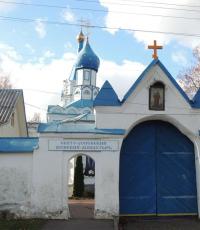Orsha Assumption Monastery. Assumption Monastery (Orsha) St. Elias Monastery Orsha Belarus
Founded in 1631 by Princess Anna Oginskaya (mother of Bohdan Stetkevich-Zavirsky), who transferred part of her land holdings with the village of Svistelki to the maintenance of the monastery, due to which in some sources the monastery is mentioned as Svistelskaya. The monastery had several wooden churches and other monastic buildings. Also, in the monastery there was a two-tiered belfry with a stone lower tier. In 1655, the stone Assumption Cathedral was erected. In 1691, the brick Church of the Nativity of the Blessed Virgin Mary was built, which existed for more than two centuries and was destroyed in the mid-1950s. In the 1920s, the monastery was closed, the temple was used as a warehouse and smokehouse. The Assumption Cathedral of the monastery has been reopened since the Great Patriotic War. Currently, multi-storey buildings have been built on the site of the monastery.
Modern Assumption Monastery
The monastery resumed its activities in 1996 in a new location at the St. Elias Church (built in 1880 on the site of a burnt wooden one from the early 16th century), which was completely renovated. A new two-story building for the sisters was built. In 2006, construction was completed and the Assumption Church of the monastery was consecrated.
see also
- List of monasteries in Belarus
Literature
- // Encyclopedic Dictionary of Brockhaus and Efron: in 86 volumes (82 volumes and 4 additional). - St. Petersburg. , 1890-1907.
- Alexander Yarashevich. Kutseinsky Assumption Monastery // Encyclopedic histories of Belarus / Editorial: G. P. Pashkov (ed.) i insh.; Mast. E. E. Zhakevich. - Mn. : BelEn, 1997. - T. 4: Cadets-Lyashchenya. - P. 321. - 432 p. - 10,000 copies. - ISBN 985-11-0041-2.
- Tamara Gabrus, Alexander Yarashevich. Kutseinsky Dormition Monastery // Vyalikae Principality of Lithuania. Encyclopedia in volume 3 - Mn. : BelEn, 2005. - T. 2: Cadet Corps - Yatskevich. - P. 174. - 788 p. - ISBN 985-11-0378-0.
WITH The Holy Dormition Convent is located on the picturesque left bank of the Dnieper. The monastery was founded in 1631 near the Kuteinka River, which now no longer exists, flowing into the Dnieper, and was named Kuteinsky. The monastery was founded by Princess Anna Oginskaya and her son Bogdan Stetkevich, who allocated land for the construction of the monastery and gave it the village of Svistelki near Orsha, along with people and land, for its use. A wooden church was built in the monastery in honor of the Dormition of the Blessed Virgin Mary, but in 1635 it burned down and a stone church with a main altar was built in its place in honor of the descent of the Holy Spirit, which was consecrated by Metropolitan Peter Mohyla. In 1655, a stone Assumption Cathedral was erected in the monastery. In 1656, Tsar Alexei Mikhailovich visited the monastery. In addition to the cathedral stone church, in the Assumption Monastery there was a warm wooden church in honor of the Intercession of the Mother of God, a stone church in honor of St. Nicholas, a two-tier gate bell tower, many residential and outbuildings, and a water mill on the Kuteinka River.
In 1691, a church was built in honor of the Nativity of the Blessed Virgin Mary, which existed for more than two centuries and was destroyed in the mid-1950s. The monastery had a miraculous copy of the icon of the Kazan Mother of God. Every year, on the day of honoring the icon, July 21 (New Art), pilgrims flocked not only from the surrounding areas, but also from distant districts of the Mogilev and Smolensk provinces. In 1842, the monastery was transferred to the first-class register, due to numerous healings of the sick from the icon. Classes at the monastery school traditionally began with a prayer service in front of the shrine.
In the 1920s the monastery was closed, the temple was used as a warehouse and smokehouse. Currently, multi-storey buildings have been built on the site of the monastery. Since 1996, the Synod decided to establish a sisterhood at the temple in the name of the Prophet of God Elijah, which marked the beginning of the revival of the Holy Dormition Convent. On April 11, 1997, by resolution of the Holy Synod, the monastery was registered. A new two-story building for the sisters was built. In 2006, construction was completed and the Assumption Church of the monastery was consecrated. Of particular spiritual and historical value is the St. Elias Church - a majestic building built in 1880. Even today it is the oldest decoration of Orsha.
According to legend, the wooden church of the holy prophet Elijah was built in Orsha around 1460 at the behest of the king and Grand Duke Casimir IV (son of Sofia Drutskaya-Golshanskaya) in memory of the salvation of his wife Elizabeth: while swimming on the day of the prophet Elijah, she almost drowned, but miraculously she was saved. St. Elias Church was built opposite the castle on the left bank of the Dnieper, but soon burned down. Already in 1515, Princess Sofia Yuryevna built a new wooden church in its place. According to legend, in 1706, during the Northern War, Peter I prayed in the Ilinsk Church for victory over the Swedes. In 1880, on the site of an ancient dilapidated building, a new, stone Church of Elijah the Prophet in the pseudo-Russian style was erected.
In 20-40 years. XX century The temple was closed and a warehouse was located here. It was opened by the Germans during the Great Patriotic War, after which it was never closed.The treasure of the monastery is the miraculous icon of the Mother of God “Orsha”, painted in the 18th century. The image was solemnly transferred to the monastery from the Holy Spiritual Cathedral on August 25, 2001. Every year on the day of remembrance of the icon, September 18 (NS), a religious procession is held, which ends at the Holy Epiphany Kuteinsky Monastery, where the icon remains until the Feast of the Entry to the Church of the Blessed Virgin Mary. On the holiday itself, December 4, the image returns to the monastery in a procession. The “Quick to Hear” icon of the Mother of God, located in the icon case to the left of the “Orsha” icon, is also revered by many as miraculous.
There are 11 nuns living in the monastery (2017). The duties of the elder sister are performed by the nun Susanna (Boiko).
CONTACTS:
Belarus, Vitebsk region,
G. Orsha, st. Ilyinskaya, 1
The Assumption Monastery is located on Vitebsk land in a picturesque place near the banks of the Dnieper. This monastery at one time was called the Kuteinsky Monastery, since it was located next to the no longer existing Kuteinka River, which flowed into the Dnieper.
The monastery was founded in 1631 on the initiative of Princess Anna Oginskaya and her son Bogdan Stetkevich, who allocated land for the monastery. Soon a wooden Assumption Church was built, although it did not last long and burned down in a fire in 1635. In its place, a stone Holy Spiritual Church was erected, which was consecrated by St. Peter (Grave). The stone cathedral church of the Assumption of the Blessed Virgin Mary was erected in 1655.
In addition to these two churches, the stone Nikolaevsky and wooden Intercession churches, a gate bell tower were also built in the monastery, and in 1691 the Church of the Nativity of the Virgin Mary was built.

In the middle of the 19th century, about 100 nuns and novices lived in the monastery.
Among the monastery shrines, the most famous was the list of the miraculous Kazan Icon of the Mother of God. On the day of her feast, many believers arrived at the monastery, even from neighboring provinces. Numerous healings of the sick were recorded from this image. In the local parish school, before starting classes, be sure to pray in front of the shrine.
The Soviet authorities closed the Assumption Monastery in 1918, and the nuns were sent to forced labor in camps. The monastery was equipped with storage rooms and a smokehouse. It is known that in the 1950s the Church of the Nativity of the Theotokos was destroyed. The atheistic authorities did not spare other buildings either. Today, high-rise buildings rise on the site of the monastery.

The restoration of the Assumption Monastery in Orsha took place in the second half of the 1990s. The Synod founded a sisterhood at the ancient city temple of the Prophet Elijah, which was the beginning of the second life of the monastery.
Separately, it is worth mentioning the majestic Elias Church - today the oldest in Orsha. Tradition says that it was built around 1460. A new wooden church was erected on the site of the one that burned down in 1515. The current stone church in pseudo-Russian style was erected instead of the old one in 1880. In the 1920-1940s, there was a warehouse in the church, which was closed by the atheistic authorities. During the years of German occupation, services were resumed in the temple, after which it was no longer closed.

By decision of the Synod, the monastery was opened in 1997. The construction of the cathedral church was completed and consecrated in 2006. As of 2017, 11 sisters live in the Orsha monastery.
Shrines. The miraculous Orsha icon of the Mother of God of the 18th century. Other icons: “Savior Not Made by Hands”, “Quick to Hear”, “Tikhvinskaya”. Reliquary cross.
Diocese: Vitebskaya.
Address: Belarus, Vitebsk region, Orsha, st. Ilyinskaya, 1
Updated: September 29, 2017 by: Alexander
Coordinates: 54°30′09″ n. w. 30°25′05″ E. d. / 54.5025500° N. w. 30.4180944° E. d. / 54.5025500; 30.4180944(G) (I)Assumption Monastery- an Orthodox monastery in the city of Orsha (Belarus), is under the jurisdiction of the Belarusian Exarchate of the Russian Orthodox Church.
Kuteinsky Assumption Monastery
Founded in 1631 by Princess Anna Oginskaya (mother of Bohdan Stetkevich-Zavirsky), who transferred part of her land holdings with the village of Svistelki to the maintenance of the monastery, due to which in some sources the monastery is mentioned as Svistelskaya. The monastery had several wooden churches and other monastic buildings. Also, in the monastery there was a two-tiered belfry with a stone lower tier. In 1655, the stone Assumption Cathedral was erected. In 1691, the brick Church of the Nativity of the Blessed Virgin Mary was built, which existed for more than two centuries and was destroyed in the mid-1950s. In the 1920s, the monastery was closed, the temple was used as a warehouse and smokehouse. The Assumption Cathedral of the monastery has been reopened since the Great Patriotic War. Currently, multi-storey buildings have been built on the site of the monastery.
Modern Assumption Monastery
The monastery resumed its activities in 1996 in a new location at the St. Elias Church (built in 1880 on the site of a burnt wooden one from the early 16th century), which was completely renovated. A new two-story building for the sisters was built. In 2006, construction was completed and the Assumption Church of the monastery was consecrated.
see also
Write a review about the article "Assumption Monastery (Orsha)"
Notes
Literature
- // Encyclopedic Dictionary of Brockhaus and Efron: in 86 volumes (82 volumes and 4 additional). - St. Petersburg. , 1890-1907.
- Alexander Yarashevich. Encyclopedic history of Belarus / Editorial: G. P. Pashkov (ed.) i insh.; Mast. E. E. Zhakevich. - Mn. : BelEn, 1997. - T. 4: Cadets-Lyashchenya. - P. 321. - 432 p. - 10,000 copies. - ISBN 985-11-0041-2.
- Tamara Gabrus, Alexander Yarashevich. Kutseinsky Dormition Monastery // Vyalikae Principality of Lithuania. Encyclapedia u 3 t. - Mn. : BelEn, 2005. - T. 2: Cadet Corps - Yatskevich. - P. 174. - 788 p. - ISBN 985-11-0378-0.
- // / auto-stat. S.E. Somov. - Mn. : "Four Quarters", 2003. - pp. 96-98. - 200 s. - (Our spiritual values). - 2500 copies. - ISBN 985-6089-85-9.
Links
- on the website of the Vitebsk diocese
Excerpt characterizing the Assumption Monastery (Orsha)
“If he scolds, I’ll leave,” said Anatole. “I can’t stand these old people.” A?– Remember that everything depends on this for you.
At this time, the arrival of the minister with his son was not only known in the maiden's room, but the appearance of both of them was already described in detail. Princess Marya sat alone in her room and tried in vain to overcome her inner agitation.
“Why did they write, why did Lisa tell me about this? After all, this cannot be! - she said to herself, looking in the mirror. - How do I get out into the living room? Even if I liked him, I couldn’t be on my own with him now.” The thought of her father's gaze terrified her.
The little princess and m lle Bourienne had already received all the necessary information from the maid Masha about what a ruddy, black-browed handsome minister's son was, and about how daddy dragged them with force to the stairs, and he, like an eagle, walking three steps at a time, ran after him. Having received this information, the little princess and M lle Bourienne, still audible from the corridor in their animated voices, entered the princess’s room.
– Ils sont arrives, Marieie, [They arrived, Marie,] do you know? - said the little princess, wobbling her belly and sitting heavily on the chair.
She was no longer in the blouse in which she had sat in the morning, but she was wearing one of her best dresses; her head was carefully adorned, and there was a liveliness on her face, which, however, did not hide the drooping and deadened contours of her face. In the attire in which she usually wore to social gatherings in St. Petersburg, it was even more noticeable how much she had looked worse. M lle Bourienne also unnoticed some improvement in her outfit, which made her pretty, fresh face even more attractive.
– Eh bien, et vous restez comme vous etes, chere princesse? – she spoke. – On va venir annoncer, que ces messieurs sont au salon; il faudra descendre, et vous ne faites pas un petit brin de toilette! [Well, are you still wearing what you were wearing, princess? Now they will come to say that they are out. We’ll have to go downstairs, but at least you’ll dress up a little!]
The little princess rose from her chair, called the maid and hastily and cheerfully began to come up with an outfit for Princess Marya and put it into execution. Princess Marya felt insulted in her sense of self-worth by the fact that the arrival of her promised groom worried her, and she was even more insulted by the fact that both of her friends did not even imagine that it could be otherwise. To tell them how ashamed she was for herself and for them was to betray her anxiety; Moreover, to refuse the outfit that was offered to her would have led to lengthy jokes and insistence. She flushed, her beautiful eyes went out, her face became covered with spots, and with that ugly expression of victim that most often settled on her face, she surrendered to the power of m lle Bourienne and Lisa. Both women cared quite sincerely about making her beautiful. She was so bad that not one of them could think of competing with her; therefore, quite sincerely, with that naive and firm conviction of women that an outfit can make a face beautiful, they set about dressing her.
“No, really, ma bonne amie, [my good friend], this dress is not good,” said Lisa, looking sideways at the princess from afar. - Tell me to serve, you have masaka there. Right! Well, this may be the fate of life is being decided. And this is too light, not good, no, not good!
It was not the dress that was bad, but the face and the whole figure of the princess, but M lle Bourienne and the little princess did not feel this; It seemed to them that if they put a blue ribbon on their hair combed up, and pulled down a blue scarf from a brown dress, etc., then everything would be fine. They forgot that the frightened face and figure could not be changed, and therefore, no matter how they modified the frame and decoration of this face, the face itself remained pitiful and ugly. After two or three changes, to which Princess Marya obediently submitted, the minute she was combed up (a hairstyle that completely changed and spoiled her face), in a blue scarf and an elegant dress, the little princess walked around her a couple of times, with her small hand she straightened a fold of her dress here, tugged at a scarf there and looked, bowing her head, now from this side, now from the other.
A year 3 versts from the city of Orsha, in a ravine through which the Kuteenka (Kuteinka) River flowed, flowing into the Dnieper River. The founders of the gentry Bogdan Stetkevich and his mother Anna, nee Princess Oginskaya, allocated land for the construction of the monastery and gave it the use of the village of Svistelki along with peasants and land (from the name of this village in separate documents the monastery is called Svistelsky). The founders ordered that the nuns and abbess of the monastery remain in the purity of the Orthodox Eastern Church and submit to the Kyiv Metropolis.
The monastery complex included four wooden churches, among which the main one was the Assumption Cathedral, a two-tiered belfry with a stone lower tier, as well as residential and outbuildings. The main temple was originally wooden, but it burned down in 1635. In the year, a new stone Assumption Cathedral was erected instead of the wooden one, which was damaged by fire.
The Assumption Cathedral of the monastery has been reopened since the Great Patriotic War.
On the site of the monastery, multi-storey buildings and secondary school No. 20 were built (there is a memorial plaque in the school yard).
The monastery resumed its activities in the year at the Orsha St. Elias Church, which was built in the year on the site of a burnt wooden one from the early 16th century. The church was completely renovated, and a new two-story building for the sisters was built.
Mention in 1903, 1905, 1906, 1910, 1911, 1912. Memorial book of the Mogilev province for 1903. - Mogilev, 1903, p. 145: http://dlib.rsl.ru/viewer/01003389001#?page=222 ; Memorial book of the Mogilev province for 1903. - Mogilev, 1905, p. 282: http://dlib.rsl.ru/viewer/01003832491#?page=442, Memorable book of the Mogilev province for 1906. - Mogilev, 1906, p. 226.




